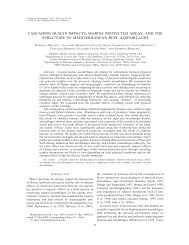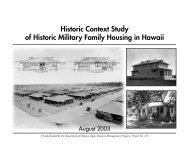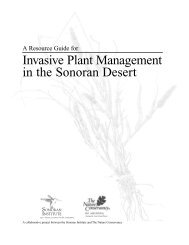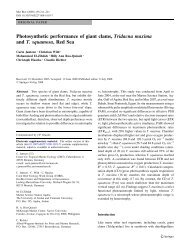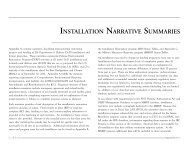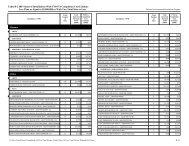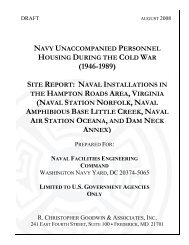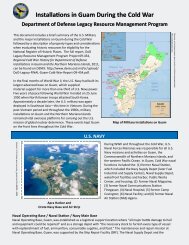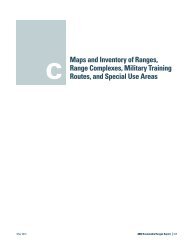Appendix M: Installation Narrative Summaries - denix
Appendix M: Installation Narrative Summaries - denix
Appendix M: Installation Narrative Summaries - denix
Create successful ePaper yourself
Turn your PDF publications into a flip-book with our unique Google optimized e-Paper software.
v�������2e���2e���������2€�—�� x€v<br />
2ppshX<br />
2ƒ���X<br />
2w������X<br />
2r‚ƒ2ƒ���X<br />
2seq2ƒ�—���X<br />
2g���—���—���X<br />
2w���—2e������X<br />
€�������2„�2h—��<br />
Longhorn Army Ammunition Plant (AAP) manufactured<br />
pyrotechnic and illuminating signal munitions and<br />
solid-propellant rocket motors. EPA placed the installation on<br />
the NPL in August 1990. The Army and EPA signed an<br />
interagency agreement (IAG) in October 1991. Identified sites<br />
included storage areas, landfills, open burning grounds,<br />
industrial areas, burial pits, sumps, and wastewater treatment<br />
plants. Longhorn AAP became inactive and excess to the<br />
Army's needs in July 1997. The Army awarded a technical<br />
assistance for public participation contract to determine the<br />
effects of on-post contamination on surface water entering<br />
Caddo Lake in FY99. The Army completed a 5-year review in<br />
FY02 for Sites 12, 16, 18, and 24. The installation updated the<br />
community relations plan (CRP) in FY03. In FY04, the<br />
installation formed a Restoration Advisory Board (RAB).<br />
Environmental studies identified 50 sites at the plant, 18 of<br />
which are eligible for the <strong>Installation</strong> Restoration Program (IRP).<br />
The installation divided the sites into five groups. Two Records<br />
of Decision (RODs) and two No Further Action (NFA) RODs<br />
have been completed to date. The Army has transferred<br />
approximately 6,800 acres to date. The cleanup progress at<br />
Longhorn AAP for FY02 through FY05 is detailed below.<br />
In FY02, the Army completed the 5-year review report for<br />
interim actions at Sites 12, 16, 18, and 24. The installation<br />
completed the perchlorate investigation and remedial<br />
investigation (RI) reports, including risk assessments, for<br />
Groups 2 and 4. It also completed the Site 16 feasibility study<br />
(FS). The Army completed an inventory of closed, transferred,<br />
and transferring ranges and sites with unexploded ordnance<br />
(UXO), discarded military munitions, or munitions constituents.<br />
The Army identified three Military Munitions Response Program<br />
(MMRP) sites at this installation.<br />
In FY03, the Army was the recipient of over $1 million of funded<br />
grant work from the Environmental Security Technology<br />
Certification Program and the National Institutes of Health for<br />
field pilot studies designed to treat groundwater contaminated<br />
with perchlorate. The Army completed a successful FS for in<br />
situ treatment of perchlorate in soils. The installation completed<br />
work plans for the background study and ecological risk<br />
Army<br />
„ˆTPIQVPHSPWHH<br />
VDRWQ2—���<br />
v�—���D2—����˜���D2—��2�—���2���������2—��2�������—����2<br />
����—�2���������<br />
QWFVQY2��—��2��2x€v2��2e�����2IWWH<br />
seq2������2��2y��˜��2IWWI<br />
i���������D2��—��2���—��D2†yg�D2�������—��<br />
q������—���D2����—�2�—���D2��������D2����<br />
2p������2��2h—��X<br />
62WWFS2�������<br />
2i��F2g„g2@g���2‰�—�AX 62IWFT2�������@p‰2PHISA<br />
2s‚€Gww‚€2ƒ����2p��—�2‚s€G‚gX p‰2PHHUGp‰2PHHW<br />
2p���E‰�—�2‚�����2ƒ�—���X g��������2—��2��—����<br />
assessment (ERA). The Army held a public meeting, compiled<br />
community surveys, and updated the CRP.<br />
In FY04, the installation conducted a transition and partnering<br />
meeting with regulators, the U.S. Fish and Wildlife Service<br />
(FWS), and other Army personnel in anticipation of the change<br />
in installation managers from Army Material Command to the<br />
Army Headquarters BRAC Division, and a transfer meeting with<br />
the FWS, the General Services Administration, and others to<br />
facilitate property transfer. The installation prepared an<br />
environmental condition of property (ECP) report and<br />
participated in the development of an overarching transfer<br />
memorandum of agreement between FWS and the Army. In 2<br />
separate actions, the Army transferred a total of approximately<br />
5,800 acres to FWS as part of the Caddo Lake National Wildlife<br />
Refuge. The installation prepared a second ECP report to<br />
support the FY05 transfer of a 125-acre tract of CERFA<br />
Category 1 land to the FWS. The installation reviewed the<br />
environmental site assessment/Environmental Baseline Survey<br />
for the Production Area. The installation achieved response<br />
complete (RC) at LHAAP 045 without an RI/FS. The installation<br />
initiated site inspections for three MMRP sites and reviewed<br />
historical record reports and site conceptual models for LHAAP<br />
001 R (South Test Area), 002 R (Static Test Area), and 003 R<br />
(Ground Signal Test Area). The installation held meetings with<br />
regulators and other stakeholders to familiarize them with the<br />
MMRP process and to generate input and approval. The<br />
installation conducted a site tour for regulators and<br />
stakeholders. The installation provided UXO, and munitions and<br />
explosives of concern recognition training to regulators,<br />
stakeholders, and interested public. The installation established<br />
a RAB.<br />
In FY05, the installation awarded a performance-based contract<br />
(PBC) to address most of the remaining environmental<br />
restoration work. The installation completed two FSs for LHAAP<br />
12 and 67. The installation completed the sitewide ERA through<br />
Step 3 and submitted the report to the regulators. The ERA is<br />
now part of the PBC performance work statement. Additional<br />
sampling and evaluation at LHAAP 32 recommended NFA. The<br />
installation completed MMRP site inspections for three sites<br />
and initiated an engineering evaluation and cost analysis<br />
(EE/CA) for each of the sites. The RAB ratified its charter,<br />
elected a co-chair, and held quarterly meetings.<br />
p‰HT2s‚€2€�������<br />
The installation completed the FS for LHAAP 37 and drafted the<br />
proposed plans for LHAAP 8, 32, 37, 48, 53, and 67. Longhorn<br />
AAP signed the ROD for LHAAP 12 and prepared the remedial<br />
design with land use controls. The Army transferred 288 acres<br />
to FWS.<br />
Funding and contractual issues delayed RC at LHAAP 4, 49,<br />
50, 55, 60, and 66. Regulatory issues delayed the RODs for<br />
LHAAP 8, 32, 37, 48, 53, and 67 and the sitewide ERA.<br />
p‰HT2ww‚€2€�������<br />
The installation completed the fieldwork for the three EE/CAs<br />
for three MMRP sites. The Army anticipates that two of the<br />
three sites will require further action. The installation found no<br />
fused munitions at any of the sites.<br />
€�—�2��2e����<br />
Plan of action items for Longhorn Army Ammunition Plant are<br />
grouped below according to program category.<br />
22222s‚€<br />
0 Complete RODs for LHAAP 8, 32, 37, 48, 53,<br />
and 67 in FY07.<br />
0 Complete installationwide ERA in FY07.<br />
0 Achieve RC and complete RODs for LHAAP 4, 49,<br />
50, 55, 60, and 66 under the PBC in<br />
FY07-FY08.<br />
0 Complete 5-year reviews of the interim<br />
remedies at Sites 16, 17, 18, and 24 and the<br />
final remedy at Site 12 in FY07-FY08.<br />
22222ww‚€<br />
0 Complete EE/CAs for three MMRP sites in FY07.<br />
u—��—�D2„��—�<br />
M-116




